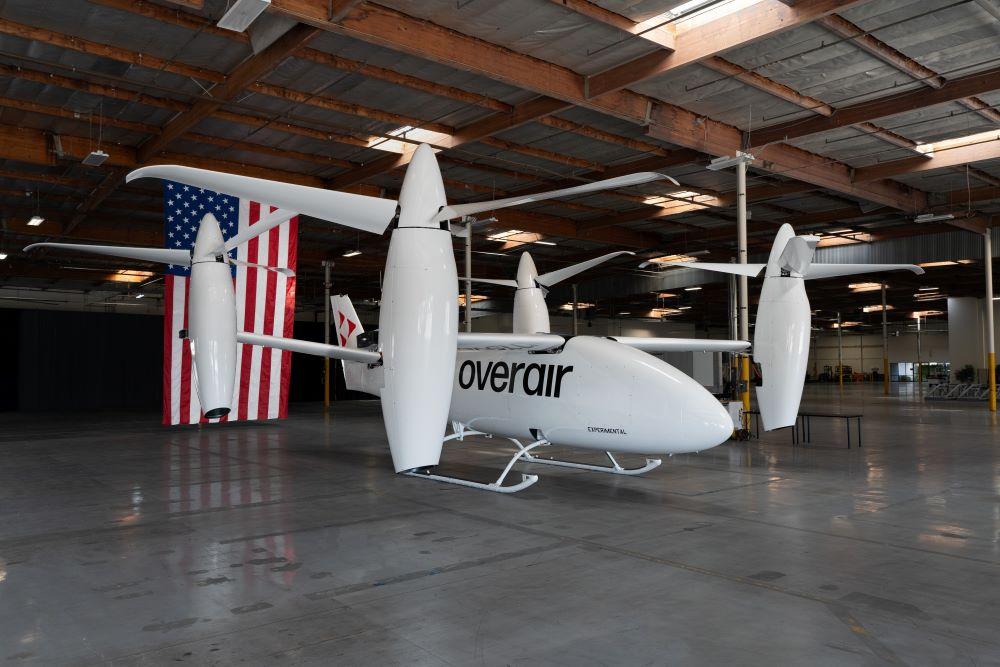
Overair’s first prototype is expected to begin ground and flight testing early next year.
Overair has announced the completion of its first full-scale prototype aircraft, paving the way for a ground and flight test campaign beginning early next year.
California-based Overair is developing the Butterfly, a piloted, five-passenger tiltrotor electric vertical-takeoff-and-landing (eVTOL) vehicle. It is distinguished by its four large, 20-ft.-span (6.1-m) slow-speed tilting rotors, which the company says can provide highly efficient and quiet propulsion.
The first Butterfly prototype, unveiled Dec. 19, is an unpiloted aircraft that does not include tilting rotors and will only be used for ground-based and vertical flight testing, according to Overair. Follow-on prototypes, expected later next year, will take the aircraft through the full flight envelope, including the crucial transition phase between vertical flight and cruise.
Initial ground-based testing of the aircraft’s propulsion and electrical systems will take place early next year at Overair’s headquarters in Santa Ana, California, before the aircraft will be dismantled and prepared for the transition to the startup’s flight testing facility in Victorville.
Speaking to the AAM Report, Overair Chief Commercial Officer (CCO) Valerie Manning says the company has already begun manufacturing its second remotely piloted test vehicle, which will include tilting rotors for transition to cruise flight. The second prototype can probably be expected “several months after” the first aircraft, with several more nonconforming prototypes to be manufactured as well for internal company testing, Manning said.
The completed first prototype includes many parts that are not the same as for the production-version aircraft, as the company is still in the process of locking in suppliers, including for key systems like avionics, fly-by-wire and batteries.
“There are some players that may end up being the same ones in the finalized aircraft, but it wasn’t the intent with this very first prototype to necessarily have all the same suppliers,” Manning says.
Aside from the large size of its rotors, the Butterfly’s propulsion system stands out for its use of Optimum Speed Tilt Rotor (OSTR) and Individual Blade Control (IBC) technology. This allows the aircraft’s flight control system to control and vary the trajectory and speed of each individual rotor blade, creating highly efficient lift while improving endurance and limiting noise.
“Basically, the whole point is about optimizing the ability of the vehicle to provide efficient lift, and to do away with the swashplate that helicopters fly with,” Manning says. “The fact that we are able to have very large propellers with very low disc loading helps us reduce vibration and noise–which is really the key to gaining community acceptance.
“But there’s more to it than just the noise for the OSTR,” Manning says. “It also helps to increase the efficiency, safety, redundancy and controllability of the vehicle. When you combine all that with being all-electric fly-by-wire, you get an extremely safe and efficient aircraft.”
Manning said the latest milestone should put the startup on track to begin for-credit FAA flight testing with a conforming prototype by early 2026. Assuming that flight test campaign lasts 18-24 months–an admittedly “ambitious” target–she said the company tentatively expects type certification by the end of 2027.
That would position Overair on track to enter into service in 2028, in time for the Summer Olympics in Los Angeles, which the FAA has identified as a key forcing function for spreading public adoption of advanced air mobility (AAM).
“You’ve got to a goal that you’re striving toward, and a great driver for us is to be in service when the Olympics come here in 2028,” Manning says. “We’re not worried about being first to market, but we want to be the best, and we think our team, our product and our technology are going to create enormous value in the marketplace.”





